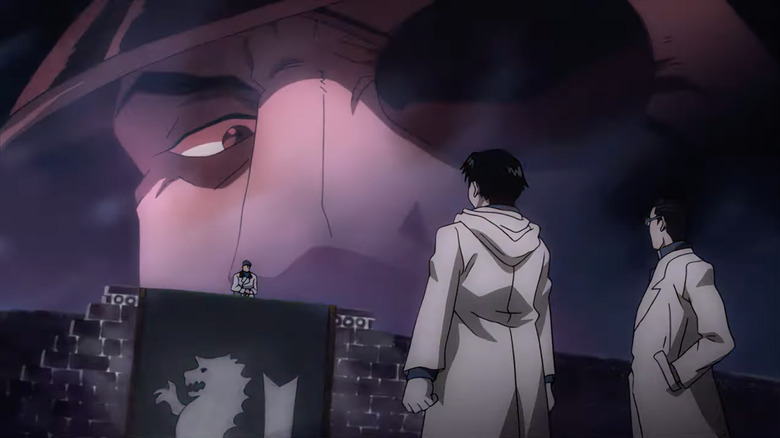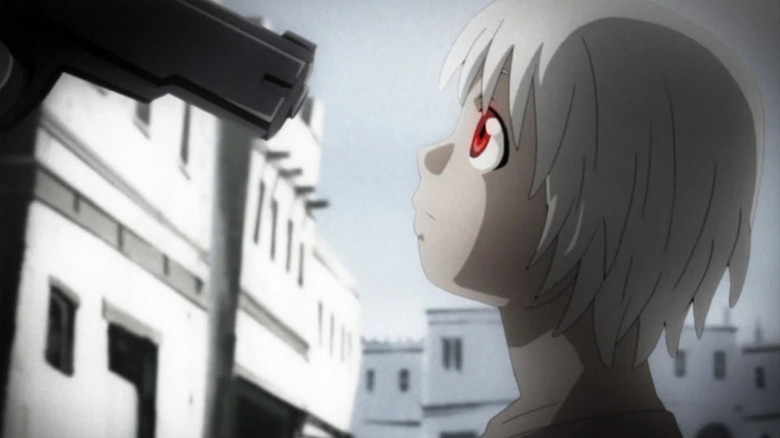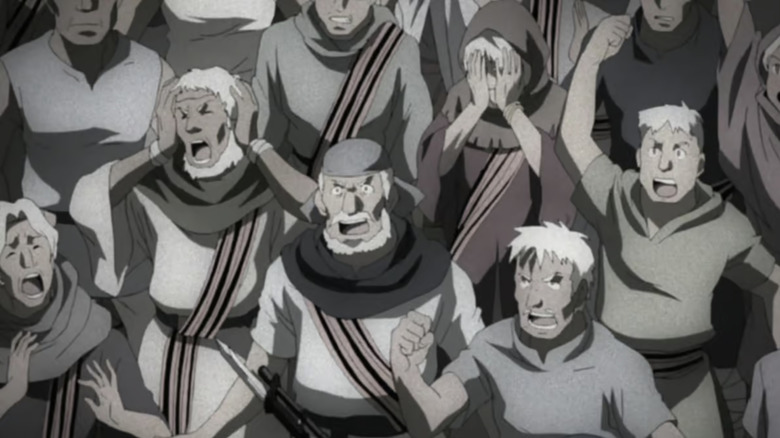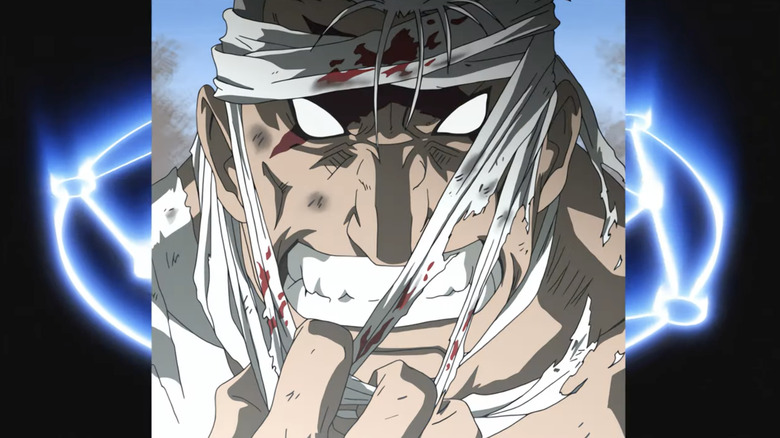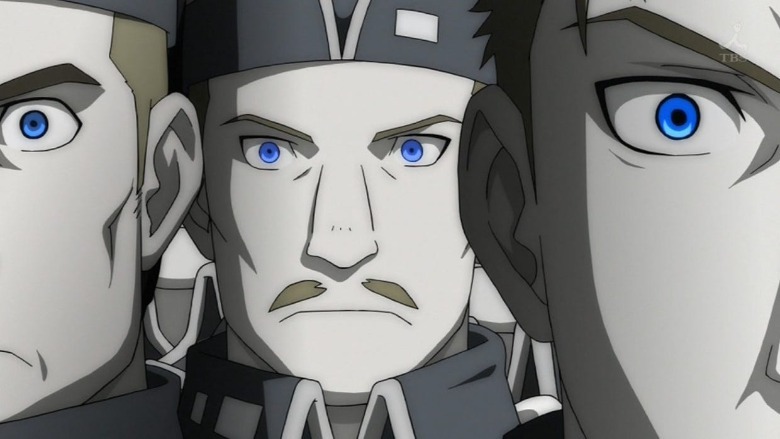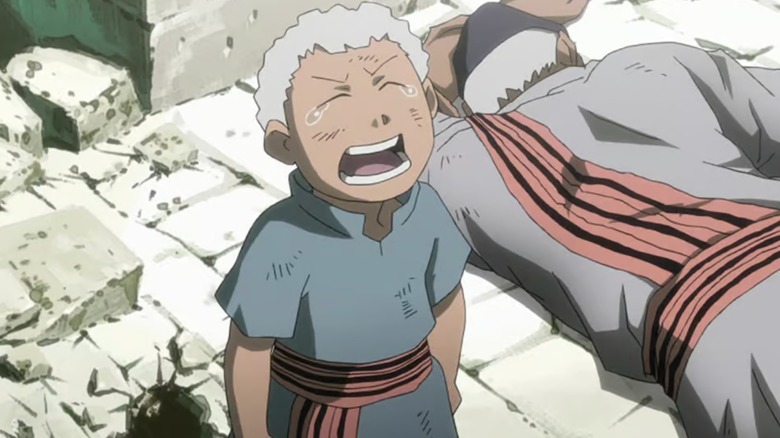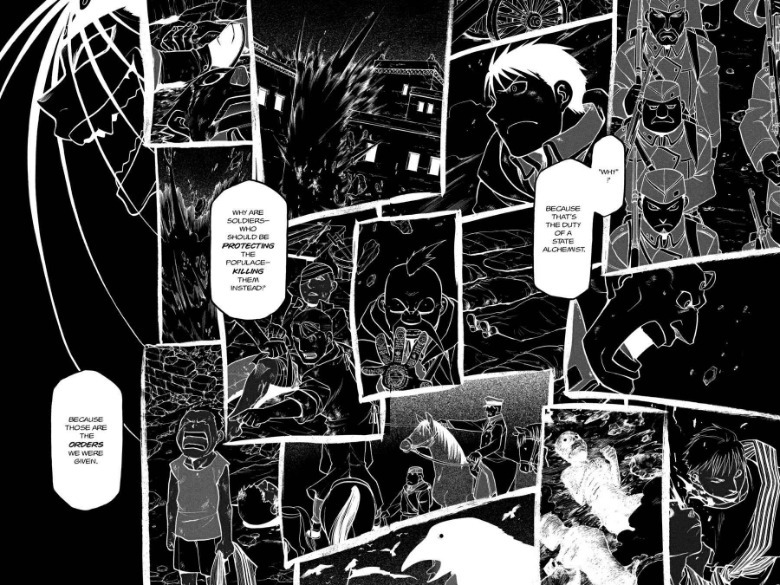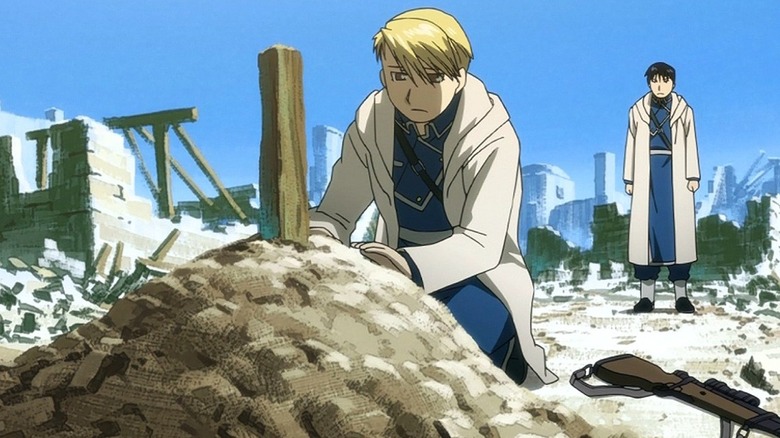How The Fullmetal Alchemist: Brotherhood Anime Shortchanges The Manga's Best Arc
In the 2000s, Studio Bones twice transmuted Hiromu Arakawa's manga "Fullmetal Alchemist" into anime. The second series, "Fullmetal Alchemist: Brotherhood," is more faithful to the source material (it helps when you have the whole story to adapt). That said, it makes changes too. Much more subtle changes than the 2003 "Fullmetal Alchemist" series, but changes nonetheless, from creating new villains to condensing the story. In particular, "Brotherhood" crams volume 15 of the manga — one of its most impactful arcs — into episode 30: "The Ishvalan War of Extermination."
"Fullmetal Alchemist" is set in a steampunk version of 1900s Europe where alchemy is a real science. The main setting is Amestris, an expansive imperial state at war on all sides and ruled by a military dictatorship from within. Alchemists can become State Alchemists ("dogs of the military") to receive grant funding in exchange for answering a call to arms when requested.
The flashback arc to the Ishvalan genocide shows what that call looks like. Ishval is a desert region annexed by Amestris, home to brown-skinned, red-eye people who follow a strict faith. Their holy ways prohibit alchemy, for shaping the world is God's duty. That means when the Amestrian military invades the region to put down dissidents with collective punishment (gee, where have we heard this before?), the Ishvalans are helpless against the State Alchemists.
"Fullmetal Alchemist: Brotherhood" cuts several moments to fit the arc into 24 minutes of anime. It's a fine episode but it doesn't quite give the story the same weight the manga does.
The horrors of war in Fullmetal Alchemist
"Fullmetal Alchemist" is more mature and thoughtful than, say "Naruto," but it is a battle shonen manga. ("Shonen" means "young boy" in Japanese, and it's used as a demographic label in manga publishing.) The Ishvalan war flashback, though, is the least shonen-esque section of the story. People with spectacular abilities, like reshaping the earth with a thought or triggering an explosion with the snap of their fingers? That's not spectacular, it's a slaughter.
In Arakawa's author note on volume 15, she writes: "In researching this volume, I interviewed veterans who had been at the front during World War II. I read countless books, examined film footage, and listened to many detailed and intense stories firsthand, but the one comment that affected me the most came from a former soldier who lowered this gaze to the tabletop and said, 'I never watch war movies.'"
There is not a single moment in the arc where the war feels triumphant. When Roy Mustang, the Flame Alchemist, is greeted as "the hero of Ishval" by his men? He can only think of the lives lost. Arakawa's real-life inspirations go further. Amestris is mostly styled after Western countries; characters write in English, most historical alchemists (such as Paracelsus and Nicolas Flamel) were Europeans, and the country is ruled by King Bradley, a mustachioed dictator called the Führer. But Japan was once an aggressive imperial state too.
In a 2006 interview with Newtype USA magazine, Arakawa admitted that the Ishvalans were inspired by the Ainu, the native people of Japanese island Hokkaido. Arakawa grew up on a Hokkaido dairy farm and she's descended from settlers who originally displaced the Ainu. (If you want to know more about the Ainu, I'd recommend manga/anime "Golden Kamuy.") Much like Native-Americans, the Ainu continue to face cultural marginalization to this day.
"Fullmetal Alchemist" confronts and condemns Japan's imperial history rather than whitewashing it the way other manga/anime like, say, "Attack On Titan" (which allegorically turns post-imperial Japan into a victim of the colonized's descendants) and "Code Geass" (where, in an alternate timeline, Japan is rewritten into a colonial victim of the West and the heroes are a Japanese resistance movement) do. These series are both anti-imperialism in general, yes, but they put the Japanese in the perspective of the disempowered when history shows otherwise.
In "Fullmetal Alchemist," an empire like Amestris is built to drain life, even that of its own citizens, and it's those citizens' responsibility to overthrow it.
The story of Ishval in Fullmetal Alchemist, explained
The manga and anime's lead is the titular Fullmetal Alchemist, Edward Elric. He became a "military dog" after he and his brother Alphonse were harmed in an alchemy experiment. The only way to heal themselves is to find the mythical Philosopher's Stone, and they'll need funds for their quest. Most of the supporting cast are military officers: Mustang, having made Colonel since Ishval, is Ed's direct superior and he's often accompanied by his right-hand Riza Hawkeye (a sniper who served in Ishval) and Major Alex Louis Armstrong, the Strong Arm Alchemist (who ran from the battle out of guilt).
Ishval is first mentioned in chapter 7, when Ed is attacked and almost killed by Scar, a man who preaches that alchemists have turned away from God. When Scar's red eyes are revealed, everyone knows he's an Ishvalan out for revenge. Mustang fills in the Elrics (and the audience) about the details; the war started when an Amestrian officer shot an Ishvalan child and raged for seven years until the State Alchemists decisively ended it in genocide.
There'd been hints that all wasn't right in Amestris before this. In chapter 3, the Elrics visit a small mining town governed by the military; Ed gets denied service at the local inn for being a "dog of the military." In chapter 4, the Elrics stop a terrorist cell from hijacking a train, suggesting internal dissidence. Then there's the simple fact that the military wields so much power in the country, and the Ishvalan genocide shows what they and their "dogs" do with that power.
The Ishvalan war continues to inform more than just Scar's backstory as further details gradually come out. Winry Rockbell, the Elrics' childhood friend, lost her parents when they were serving as frontline doctors during the war — as Ed later learns, it was Scar who killed them. Dr. Tim Marcoh, a former state alchemist in hiding, created a Philosopher's Stone by harvesting the souls of captive Ishvalans. Another State Alchemist, Solf Kimblee, became fueled by bloodlust and was imprisoned when he killed his own superiors.
The villains of "Fullmetal Alchemist" are homunculi named for the seven deadly sins of man, and it's ultimately revealed the Ishvalan genocide was their doing. Führer Bradley is the homunculus Wrath, while the soldier who killed the Ishvalan child was the shapeshifting Envy. A sadist, Envy is all too proud of having "ravaged an entire country with a single bullet." By the time Ed finally asks Riza to tell him about the war, we too are dying to know the whole picture.
How Fullmetal Alchemist: Brotherhood changes the Ishvalan War arc
"Fullmetal Alchemist: Brotherhood" moves some scenes from the Ishvalan War arc up; namely, those featuring Scar. In episode 22, "Backs in the Distance," while the Elrics are fighting Scar, Winry overhears that he killed her parents and, sobbing and trembling, aims a gun at him. The episode flashes back to how Scar spent the end of the war.
His brother was studying alchemy, intending it to help his people, but Scar saw it as only good for violence. Kimblee blew up their home, with Scar's brother shielding the blast with his own body. Scar awoke under the Rockbells' care and, still in shock from losing his family and the sight of "blue-eyed devils," grabbed a knife and took the lives of the people who saved his.
The anime adds a detail in these scenes that shows how it uses its medium apart from the manga. Most of Scar's flashback in "Brotherhood" has a standard gray filter, except for the Amestrians' blue eyes. Since that's what triggers him, it makes sense to highlight it and this is something a black-and-white manga can't do.
In both the manga and "Brotherhood," that encounter with Scar is what sends Ed to Riza. The third title sequence of "Brotherhood" — "Golden Time Lover" — prominently features scenes from the Ishvalan War, suggesting it will get more focus than it does.
Episode 30 proceeds roughly like this: a flashback reveals Mustang's flame alchemy was developed by Riza's father, Berthold Hawkeye (he tattooed his research on her back to keep it secret). Inspired by Roy's dream of reforming the country, she gave her father's secrets to him and enlisted. Cut to Riza in the present greeting Ed, and her story goes as follows: she offers context for the war and explains the Führer signed an order declaring all Ishvalans were to be killed. Cue a montage of State Alchemists and soldiers killing Ishvalans.
Mustang talks to his friend Maes Hughes, lamenting how naive their dreams of the future were. When he reunites with Hawkeye, he observes that she, like him, now has the eyes of a killer — but Kimblee tells them they were fools if they expected they could be soldiers without killing. When the Ishvalan leader surrenders, offering his life for his people, Bradley refuses; invoking alchemy's principle of equivalent exchange, Bradley says that one life can't substitute the value of thousands and mocks the Ishvalans for following a god who wouldn't save them. As the Amestrian troops prepare to move out, Mustang and Hughes vow to "climb to the top of the rat's nest," glaring at Bradley and not averting their eyes even when he stares back. The episode returns to the present, where Riza explains to Ed that she and Roy have sworn to make Amestris into a democracy and de-arm the military, even if this means they'll wind up on trial for their war crimes afterward.
Does Fullmetal Alchemist: Brotherhood let Mustang and Hawkeye off too easy?
Those are all scenes in the manga; the anime has the spine of the arc, but cuts off a lot of the meat. The manga has a longer build-up to the failed negotiation, where Colonel Basque Grand frags his superior (who refuses the surrender). There are also cut subplots, like Kimblee being assigned to kill the Rockbells (since they were helping the Ishvalans) before Scar beats him to it, or the nation Aurego aiding the Ishvalans to destabilize Amestris. In general, by spending less time with the war, it isn't as affecting. Take this two page spread from Chapter 60, showing a collage of the carnage.
This is something a manga can do that an anime can't; place multiple scenes from different times next to each other in a still image. The closest the anime comes is a montage of death and destruction in Ishval, but even that has almost the opposite effect; a montage overwhelms you with change, while a page forces you to linger.
The lessened violence can't help but feel like letting the "good" guys off the hook. In "Brotherhood," Hawkeye simply walks up to Mustang and Hughes. In the manga, an Ishvalan ambushes them but she snipes him. This is way better; it reinforces that nowhere is safe in war, that Mustang and Hughes are walking on stolen land, and makes Roy's comment that Hawkeye has the eyes of a killer more meaningful.
Mustang blows up some buildings in "Brotherhood," but he straight-up executes Ishvalan civilians in the manga. The last one he kills can feel Mustang's hesitation, so they smile and say their last words: "I'll never forgive you." If there was one cut moment from the manga that needed to be in the anime, it's that. It's no wonder Arakawa refrained from giving Mustang a pure happy ending.
The flashbacks in the manga open with Scar and his brother discussing alchemy and the theory of positive and negative flow; the world gives back what we put into it. This transitions to the Rockbells helping the Ishvalans (positive flow), which in turns becomes Bradley signing the extermination order (negative flow). The flashback ends with Mustang and Hawkeye swearing they have a duty to change Amestris and protect as many lives as they can, while Scar swears he lives only for vengeance.
These moments of parallelism get lost in translation in "Brotherhood," as does the manga's ideas about how the entire war is about forces for good (alchemy, soldiers wanting to protect their people) being perverted for evil. The Ishvalan War arc embodies the larger themes of the story (the value of life, the need for community, etc.), but that feels diminished in "Brotherhood."
"Fullmetal Alchemist: Brotherhood" saves one scene from volume 15 for episode 54, "Beyond The Inferno." Mustang is about to execute Envy, who killed Hughes earlier in the series, but Hawkeye raises her gun to Roy, ready to fulfill a promise to shoot him should he walk off the right path. The episode cold opens with an Ishvalan War flashback, when Riza (burying an Ishvalan child) asks Roy to burn her back tattoo and destroy her father's research, ensuring no-one can use flame alchemy like he did again. I don't think the scene is better placed here, but it is an appropriate moment to remind us of how strong Mustang and Hawkeye's bond is.
How Fullmetal Alchemist: Brotherhood runs through flashbacks
Guilt and having to move forward while carrying it is a big theme of "Fullmetal Alchemist." See Ed's pocket watch, inscribed with the date "Oct. 3, [19]11," the date he and Al set out on their journey. There are three major flashback arcs in "Fullmetal Alchemist," each one exploring what mistake the main characters have to make up for.
With Mustang and Hawkeye, it's the Ishvalan War arc. Ed and Al's comes earlier in chapters 21-24, revealing how they tried to bring their mother back to life with alchemy, only to discover why "human transmutation" is forbidden. The third and final one in chapters 74-75 is about the Elrics' father, Van Hohenheim. Centuries ago, he was an enslaved person in the nation Xerxes, until he met a homunculus his master had created. That homunculus manipulated the king of Xerxes into turning his entire nation into two Philosopher's Stones, making the homunculus and unwilling Hohenheim immortal. Now, that homunculus has become the father of the others and intends to repeat his old trick on Amestris; only Hohenheim knows how to stop him.
Each of these arcs take up multiple chapters of the manga, but are condensed into one episode each of "Brotherhood" (episode 2, "The First Day," for the Elrics' backstory and episode 40, "Homunculus," for Hohenheim's). Of these three, the Ishvalan War definitely has the most material cut. "Fullmetal Alchemist: Brotherhood" has breakneck pacing, which is part of what makes it such a great, exciting show. I just think it could've been even greater if it knew when to slow down a tad like the manga does.
